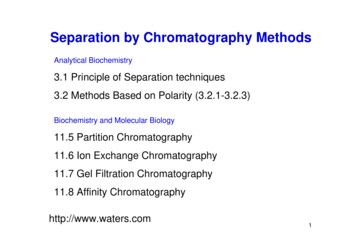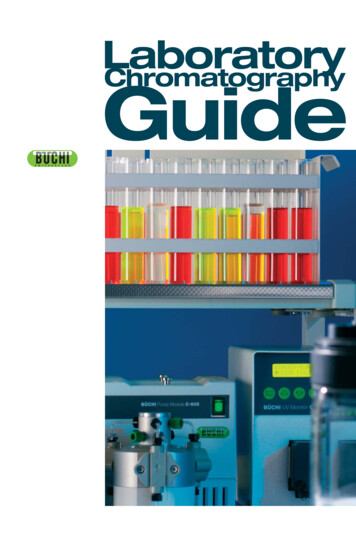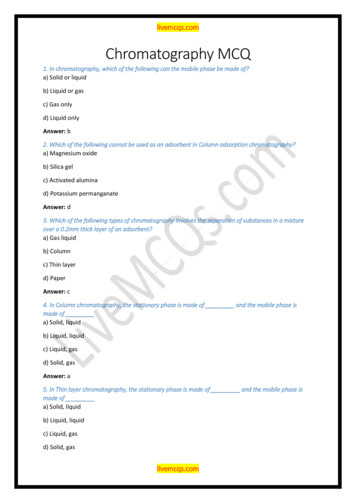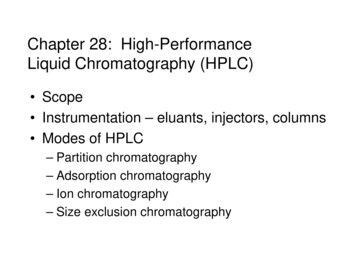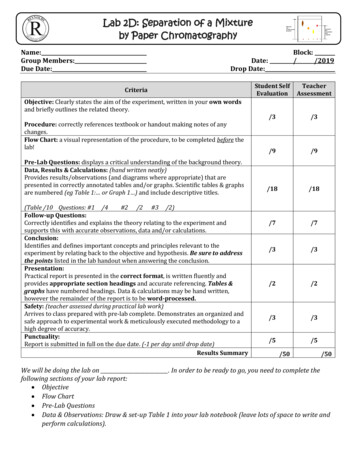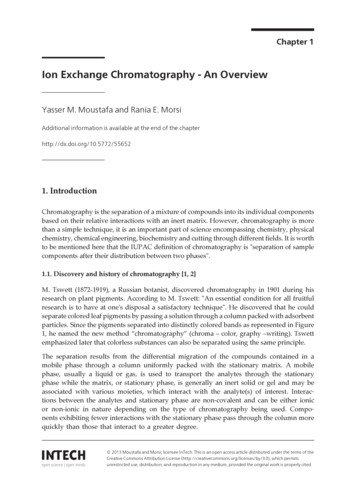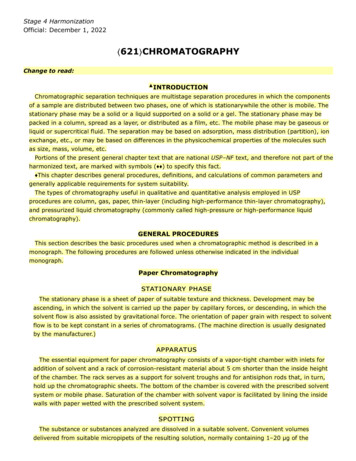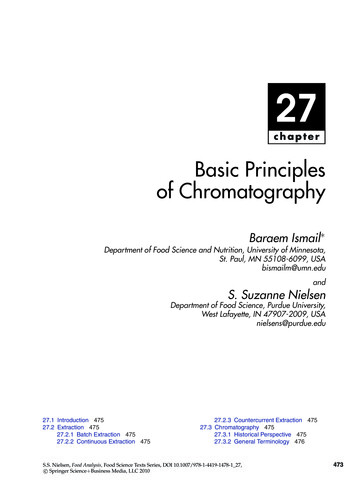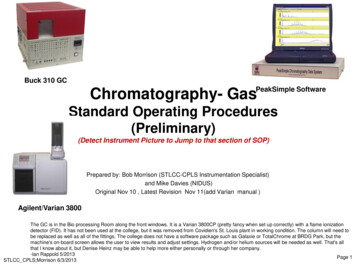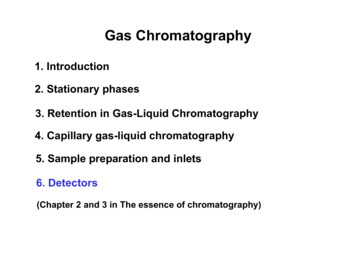
Transcription
Gas Chromatography1. Introduction2. Stationary phases3. Retention in Gas-Liquid Chromatography4. Capillary gas-liquid chromatography5. Sample preparation and inlets6. Detectors(Chapter 2 and 3 in The essence of chromatography)
Detectors1. Thermal conductivity detector (TCD): Bulk physical property2. Ionization Detectors:3. Optical Detectors4. Electrochemical detector5. Spectroscopic detectors (Chapter 9)
1. The Basics for Detectors:a. Minimizing extra-column band broadeningb High-sensitivity detection(1) Limit of Detection: what is the smallest amount of solute to bedetected?S/N 3(2) Sensitivity: How small of a change in mass or concentrationcan be detected?How fast its signal changes with a change in theamount or concentration of solutes
(3) Linearity or dynamic range: what mass or concentrationrange can be detected?
(4) Selectivity: What compounds are to be detected (all or a few)?i. A universal detector is one which shows a response for all solutesii. A selective detector is one which responds to only certain typesof solutes.2. Thermal Conductivity Detector (TCD)a. Detector design of TCD is based on an electronic circuit knownas Wheatstone bridge.b. When a current is applied, the voltagebetween pints ( ) and (-) in the circuit willwill be zero as long as the followingrelationship is true:R1/R2 R3/R4
c. In a TCD, one of these resistorsis placed in contact with mobilephase leaving the column andanother in a reference streamcontaining only pure mobile phase.d. As current is passed throughthe circuit, the wire in the resistorsare heat. For those in contactwith the mobile phase and referencestream, some of this heat isremoved.e. Temperature changes leads toresistance changes of resistors.f. Most compound separated in GC havethermal conductivity of 1-4 X 10-5.
f. Selectivity:The response of a TCD is about the same for all compounds.Exceptions include low MW compounds ( 40 MW), which may showhigher responses.g. Limit of detection: 10-7 Mf. Linear range: a 103-fold range; dynamic range: a105-fold range3. Ionization Detectors:a. Flame Ionization detector (FID)i.The FID is the most common type of GCdetector (universal detector).ii. The FID measures the production of ionswhen a solute is burned in a flame. Theseions are collected at an electrode and createa current, allowing the solute to be detected
iii. A hydrogen/air flame is commonly used in FID since on ionicspecies are usually produced by this fuel mixture. This gives rise toa zero background current.
iii. Limit of detection: 10-10 Miv. Linear range: a 105-fold range; dynamic range: a107-fold range
b. Nitrogen-phosporus detector (NPD) Flame Ionization detector (FID)i. The NPD is also known as an alkali flame ionization detector (AFID)ii. A NPD is based on the same basic principles as an FID.However, a small amount of alkali metal vapor in the flame,which greatly enhances the formation of ions from nitrogen andphosphorus-containing compounds. The NPD is about 300-foldmore sensitive that an FID in detectingnitrogen-containing compounds, and 600-foldMore sensitive in phosphorus-containingcompoundsiii. Applications: Organophosphate and indrug analysis For determination ofamine-containing or Basic drugs.iv. Limit of detection: 10-10 Mv. Linear range: a 106-fold range
c. Electron capture detector (ECD)i.The ECD is a radiation-based detector selective for compoundcontaining electronegative atoms, such as halogen.ii. Principle:(i) An ECD is based on the capture of electronsby electronegative atoms in a molecule. Theelectrons are produced by a radioactivesource, such as 3H and 63Ni.N2 βAr2 β-N2 eAr2 e-A trace amountof methane(ii) In the absence of solute, a steady stream ofthese secondary electrons is produced that goesto a collector electrodes and produce a current(iii) As a solute with electronegative atoms elute from column, the soluteCapture some of the secondary electrons, reducing the current.
iii. Applications: An ECD is selective for any compounds withelectronegative atoms such as halogen (I, Br, Cl, F),and sulfur-containing compounds.iv. Limit of detection: 10-14 M to 10-16 Mv. Linear range: a 103 to 104-fold range
4. Optical Detectorsa. Flame photometric detector (FPD)i.The FPD is a selective detector usually used for phosphorus- andsulfur-containing compounds.ii. Principle:The FPD is based on the release of lightfrom excited atoms in a flame. The selectivityOf an FPD comes from the detection ofLight at an emission wavelengthCharacteristic for the element of interest.Iii By including a collector electrode aboveThe flame, the same detector can be used bothAs an FPD and FID.
iii. Applications: An FPD is selective for any compounds containingany atoms emitting light in the wavelength monitored.It is usually used for detecting phosphorus- and sulfurcontaining compound, which emit light at 526 and 394 nmrespectively.iv. Limit of detection: 10-14 Mv. Linear range: a 104 for phosphorus, and a 103-fold range for sulfur
b. Atomic emission detector (AED)Excitation source: plasmas (i.e., inductively coupled argon plasmas
5. Electrochemical detectorElectrolytic conductivity detector (ELCD). The ELCD is used primarilyAs an element-selective detector for halogen-, sulfur- and nitrogenContaining compounds.
Detectors1. Thermal conductivity detector (TCD): Bulk physical property2. Ionization Detectors:3. Optical Detectors4. Electrochemical detector5. Spectroscopic detectors (Chapter 9)
Gas Chromatography1. Introduction2. Stationary phases3. Retention in Gas-Liquid Chromatography4. Capillary gas-liquid chromatography5. Sample preparation and inlets6. Detectors(Chapter 2 and 3 in The essence of chromatography)
a. Flame Ionization detector (FID) i. The FID is the most common type of GC detector (universal detector). ii. The FID measures the production of ions when a solute is burned in a flame. These ions are collected at an electrode and create a current, allowing the solute to be detected f. Linear range: a 103-fold range; dynamic range: a105-fold range
